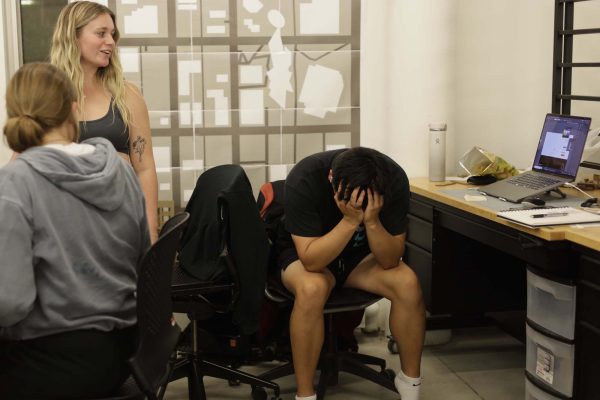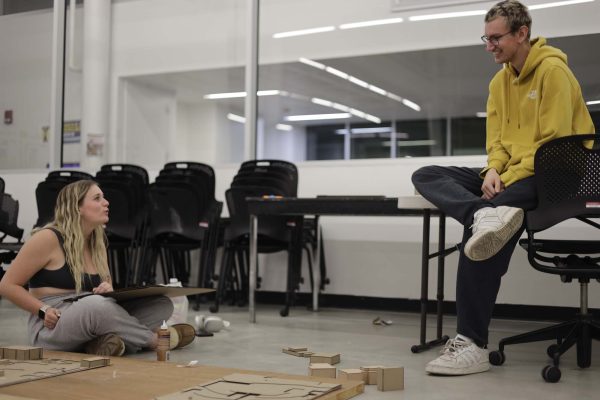Just before 5 a.m. on a Wednesday morning, two architecture students hunch over a miniature 3D model of Denver in one of the many studios in the College of Design.
Their Kraft board representation of carefully measured buildings and streets is due for a checkpoint critique when their class convenes later that day. But it is not quite ready for their professor’s careful examination.
Though the large studio space is covered with various material scraps, computers and drawing tools, the room is devoid of people except for Allison Lassiter, Morgan Schofield and the building’s night-time janitor.
“It’s just you and me Allison, who’s gonna stay longer?” Schofield asks.
“I can’t let you win that one,” Lassiter says.
Several hours earlier, the room had been packed with several of their classmates. But as the night, and then morning, wore on, the number of students in the studio slowly dwindled down to two.
Despite her bravado, Lassiter left the studio about half an hour later, leaving Schofield to emerge from the building as the last student standing at around 6 a.m.
On Sept. 27, Schofield spent more than 15 hours straight in the College of Design, except for a 20-minute break to grab food. It was not the first time and would most likely not be the last.
Long work sessions like these are a common experience for many architecture students due to continuous deadlines for studio projects. When paired with project feedback sessions that some students describe as “paralyzing” and “intense,” architecture seals its reputation among many students as a difficult degree to obtain.
“Architecture school is not for the faint of heart,” said Thomas Anderson, a fourth-year studying architecture. “You have to be very strong-minded and strong-willed.”
However, the same students also praise the major for the close community it provides and the benefits it provides to their careers.
“I think it’s worth it at the end of the day,” said Hannah Banaszak, another fourth-year architecture student with Lassiter, Schofield and Anderson. “You definitely have to love it to do it. Otherwise, you are going to drop out. But if you’re willing to put in the time and the effort, I’d say it’s one of the most rewarding majors.”
The time commitment
While Schofield and Lassiter prepared their class’s 3D model of Denver, Jaia Sundo and Attiyah Lazard progressed through their own project in another studio.
Sundo and Lazard, both second-year students in architecture, were working in a studio with another classmate at 1:45 a.m. and estimated they still had three to four hours of work left on their project, which was due that day.
Though college students from all majors are typically familiar with the occasional late-night study session, many of Iowa State’s architecture students say they find themselves in this position regularly.
Studio classes are often part of an aspiring architect’s education and are included throughout Iowa State’s entire architecture program. These classes take place in one of the various studio spaces located in the College of Design and are dedicated to the hands-on application of various topics through assigned projects. They can range from four to six credit hours, according to the Iowa State course catalog.
Edwin Villaron, a third-year studying architecture, said his fall 2023 studio met three days a week for four hours, and he estimated he spent an additional six or seven hours a week working on his projects outside of in-class work time.
“That [four hours] seems like a lot of time, but at the same time not really because you have so many things to do,” Villaron said. “You gotta, kinda have to find time whenever you can.”
For some students, including Villaron, this work time is often found in the late night or early morning hours.
“Sleep is definitely an issue because it’s currently 1:05 a.m., and I’m only like halfway done,” Villaron said.
Sundo said she goes to bed at 1 a.m. or 2 a.m. most days and that there were 10 or 15 people in her studio on an average night during the fall 2023 semester, with at least 30 people when a larger project was soon due.
“I have a lot of people that I know that have done majors like this, and they told me, ‘Good luck sleeping,’” Lazard said. “So eventually I just knew that this would be my choice.”
Anderson said many of the architecture students, including himself, are used to the tight sleeping schedule and the things that accompany it.
“I think a lot of us drink energy drinks or pop,” Banaszak said. “I think almost all of us have a caffeine addiction. If someone came in here and was like ‘I only drink water,’ I’d be like ‘I don’t know how you do it.’”
Anderson said he knows that some people like to take naps on the concrete floor in the studio, which he has also done before. Banaszak said she slept on a desk once.
“If you gotta sleep, you gotta sleep,” Anderson said.
Villaron said committing extra time is not required to complete the assigned projects, but the additional work time is necessary for students who prioritize producing higher quality work.
“It really depends on the person, how much work you really want to put into it,” Villaron said. “But I’m satisfied once I’m satisfied, and right now, I’m not satisfied.”
For Banaszak, facing a critique with an incomplete or unpolished project is a strong motivator for completing the work instead of going to bed.
“It’s not like you’re getting a grade that says 75%,” Banaszak said. “Somebody’s ripping you to shreds and telling you that your work is only 75% done. It hurts more when somebody’s telling you that you essentially failed, that you didn’t do good enough work, rather than just seeing a 75% on a screen. So you want to avoid that and just keep working.”
Lassiter added that showing finished work is a large part of the hiring process within architecture. Turning in an incomplete project can be damaging in the long run because that leaves an incomplete project to show to future employers.
“Especially for fourth years, we have to have sufficient enough work when going to get internships and jobs,” Lassiter said. “That’s a massive motivator for me personally because I want to get into a good job, and I want to secure a position early if I can.”
Lazard said she had not seen her roommates in a week at that point, but the amount of time she has away from the studio varies depending on the week and the project deadlines.
“If you’re working on a project and have a harsh deadline, you probably won’t see roommates or your friends,” Lazard said.
“…Or daylight,” Sundo said.
Anderson said that when he stays overnight in the studio, he can still watch the time pass by through the sunlight in the windows, which can add an interesting effect to his all-nighters.

“Definitely the first few times it’s kind of weird being in here all night, and then you literally see the sun go down and then see it come back up—[it] is so strange,” Anderson said. “Honestly, it’s like the worst feeling ever knowing that you stayed up long enough to see sunrise.”
On a day like Sept. 27, when the clock is ticking down toward a deadline, eating, in addition to sleeping, can become a side priority.
“It sounds terrible, but sometimes you don’t have a choice, and there are times where you kind of forget to eat, or you just don’t get enough sleep because you have to do an all-nighter back-to-back,” Villaron said.
Anderson said self-awareness is a key part of success in the major, and it is important to find the balance of what is best for both themselves and their projects.
“A lot of times instructors are like, ‘Your mental health comes first,’ and I think a lot of us maybe still are learning how to manage that,” Anderson said. “Because then there’s also, you know, the instructors are pushing you to meet all the expectations, so it goes back to this challenge of self-awareness.”
Schofield said he had an adjustment period to learn how to manage his health and his workload during his second year, which many students acknowledge as the program’s weed-out year.
“I didn’t sleep for 60 hours straight. I was on energy drinks, Adderall. I was hallucinating towards the end. It was intense, but now I don’t do that anymore,” Schofield said.
Villaron also said his second year was the most challenging since it was his first experience with the actual architecture program. Iowa State students must spend a year in the general pre-design degree before beginning their architecture degree.
“It’s a different lifestyle for sure, but you know, you get used to it, I guess,” Villaron said. “My first year in actual architecture I did not have a good grasp on the new lifestyle.”

Villaron said he has an easier time balancing his life now that he is in his third year. He has a stronger foundation in the skills and software he needs for his projects, and he has a better grasp on who to communicate with if he is struggling.
“It’s just like other students getting into the flow of our schedule,” Anderson said. “You get used to it pretty quick because you kind of have to in order to stay on top of stuff.”
The emotional demands
Anderson, Banaszak and Lassiter said the architecture program can be mentally and emotionally demanding due to the critiques each student is required to participate in. Critiques are a common method of assessment and feedback utilized in architectural education where students present and discuss their projects with their classmates, professors and other evaluators.
“Sometimes [the instructors] can be mean, so you have to have a thick skin and be motivated to want to do better. Otherwise, you’re going to kind of stay stagnant,” Banaszak said. “It helps you learn, but you have to be willing to take it.”
Anderson said he remembered one of the first model-making exercises a professor assigned during his second year, where the projects were ripped up and thrown in the trash if they were not considered a proper model.
“It just takes a lot of time to adjust to that type of criticism and intensity,” Anderson said. “You’re spending countless hours designing, building, drawing, just to have a bad critique, so you have to learn that nothing will ever be perfect and it’s never personal. Otherwise, honestly, I think you’re set up to fail.”
Anderson said design is very subjective, so it is essentially impossible to go through five years of architecture or design school without experiencing a bad critique.
“The first time, or first few times, [getting a bad critique] is kind of paralyzing,” Anderson said.
“You’re just standing up there in front of everyone that you’ve been working with all semester, and you can see their faces change because they essentially sit behind the reviewers.”
Banaszak compared the critiques to the moment when a parent says they are not mad, just disappointed, and Lassiter said many students, including herself, often need to leave the area afterward to go to the bathroom or grab a drink and debrief for a moment.
Many, however, agreed that the critiques are beneficial and help them grow into their future profession. Anderson also said it is helpful to have a fresh set of eyes on their projects since they spend a lot of time looking at them.
“In hindsight, I do think it’s good to have those bad critiques because I think it does make your design process and what you’re doing stronger,” Banaszak said. “It gives you a feeling of ‘I want to keep pushing myself and get better.’ It’s a good motivator, but in the moment it’s awful.”
The community
Villaron said students in the architecture program typically build a tight-knit community since everyone is always in the studio together working on their projects.
“I’m pretty comfortable having a conversation with almost everyone because we all kind of struggle together, do it together,” Villaron said. “So we all kind of become one big family almost.”
Lassiter said architecture students within the same year attend the same classes at the same time each day, which also helps grow the relationships between one another. Additionally, they have studio trips each semester where they travel to various sites, which gives them another opportunity to grow closer.
Due to the intensity of the major, the community built within it can provide an important support system for students. Banaszak said she probably would have dropped the major after her second year without her strong connections within the department.
“If you don’t have supportive people around you, it’s really really tough,” Banaszak said. “I definitely feel like with some people that have dropped out throughout our years, you just didn’t really know them very much, which plays into the fact that they didn’t have a support system.”
Banaszak said she and her classmates know each other really well because their late nights in the studio can often lead to deep and personal conversations.
“The relationships with each other can be very sarcastic and dry, but then sometimes it’s very personal and deep, and I think it’s kind of nice,” Anderson said.

The community built within the major also offers a friendly but competitive environment that can often help its members excel at their craft.
“There’s kind of this push and pull of competitiveness versus camaraderie,” Anderson said. “You’re trying to push yourself and see how far you can go and then see if you can excel beyond other people. But on the flip side, you have to be able to help each other out and push each other just as much as you’re pushing yourself.”
Banaszak said the architecture program feels like its own world, which she said can be both good and bad. While the community offers substantial support to many of its students, the program can also hinder their ability to engage with other areas of campus.
“It’s definitely a challenge. I used to be involved in extracurricular stuff, and then I decided that it was best for me to focus on architecture and have that time for architecture,” Anderson said.
Anderson said that even when they hang out with friends outside of class and the studio, they mostly end up being with people in the architecture program. He thinks part of this may be due to a mutual understanding of their lifestyle.
“My boyfriend sees the end, but he doesn’t see that I was sitting here at three in the morning making a block,” Banaszak said. “So it’s kinda like that, like people don’t necessarily see everything that we do, and they don’t quite understand it.”
However, some students, like Banaszak, are still able to find a balance. Banaszak is a member of the Sigma Kappa sorority, and she estimates that there are around 10 other students in her class who are also involved in greek life.
“It’s really hard to balance, but if you can do it, then it’s definitely really rewarding,” Banaszak said.
The final outlook
Banaszak and Villaron said one of the most rewarding aspects of the architecture program is being able to physically see their work come to fruition, which offsets the late nights and difficult critiques.
“I like what I do,” Villaron said. “I find it satisfying because I’m putting this hard work in, and at the end of the day, I produce something that I didn’t know I was capable of.”
For Schofield, everything included within the architecture program is what they each signed up for and is a part of the learning process.
“I’m kind of just embracing the process because we’ll never go through design school again, and I think it’s an amazing experience,” Anderson said. “It’s really intense. It’s really hard. But I think it sets us up to be successful in the future.”
























John Stein | Jan 26, 2024 at 12:48 pm
Sounds intense! Are there any double majors out there in architecture and landscape architecture? Wonder what that might be like. Fantastic window into the major, Katelyn Squiers!!
Susan squiers | Jan 26, 2024 at 11:22 am
Thank you Katelyn Squiers for an interesting article. Great reporting
Rhonda Martin | Jan 26, 2024 at 6:42 am
This was also my experience when I attended ISU as a landscape architect student. Loads of work and long nights in studio but so rewarding and fun also.